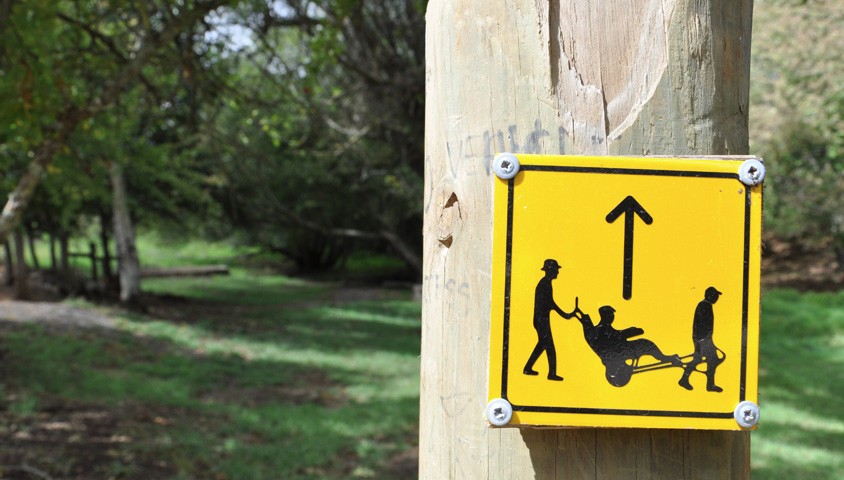The first professionally surveyed and signposted track in the world for TrailRiders opened in Daylesford in Victoria this March.
The five kilometre trail through the rehabilitated former gold mining settlement on Cornish Hill takes in hilly terrain up to 580 metres above sea level, through eucalypt forest and past the town’s main lake.

Rookie hikers (left to right): Ceilidh Wratten, Sam Hitchman, Dominic Daly, Alex Hitchman, Brandon Voight and Tara Hicks with Dave Stratton at a mineral spring water stop on the world’s first fully surveyed and signposted TrailRider trail.
Rookie hikers from the Daylesford Second College had not trained before they took to the hills with retired computers lecturer and 73-hilogram David Stratton on board to blaze the trail for the first time.
With hands firmly gripping the four handles of the strange-looking perambulatory device, a team of students from years nine to 11, under the watchful eye of volunteer “TrailRider Sherpas” Rodney and Joanne Brooke, Ros Hart, Parks Victoria Community Activation Co-ordinator John Kenwright and geography teacher Brendan Murray, took to their guiding and steering role with aplomb.
Ceilidh Wratten, 15, declared it an amazing experience.
“I’d never heard of TrailRiders before. They’re well designed so you don’t feel too much weight. It balances out but some of the hills got a bit hard. You’d definitely need a team of people who were ready for it if you wanted to do anything higher.”
The TrailRider is the brainchild of former Vancouver Mayor Sam Sullivan, made tetraplegic in a ski-ing accident. The English-born, Australian mountain hiking Dave Stratton discovered one on Cypress Mountain, north of Vancouver, while holidaying over there and relented when friends insisted he try it.
“I was really not that interested because it looked too terrifying,” the 61-year-old now admits. But the experience blew his mind and re-opened possibilities he thought long dead after multiple sclerosis left him unable to walk.
The non-motorised chariot of ultra-light aluminium – it weighs 20 kilograms – is a cross between a wheelbarrow and a sedan. It requires at least two sherpas or guides, one each at front and back, whose chief job is to ensure it doesn’t topple sideways. More are needed in more challenging terrain.
The rider is strapped in, ambulance trolley-style, with belts around the ankles, knees, hips and waist. Hands are free but otherwise his or her fate rests with the team that pushes and pulls the handles at both ends.
“There is a psychological aspect to this,” Dave said. “The TrailRider is terrible if the rider cannot reach the mental place of trusting the sherpas. The rider is quite absolutely dependent on the helpers.”
His stepsons, in their 20s and 30s, and his friend Rodney Brooke, hauled him up Boronia Peak in Victoria’s Grampians (maximum elevation 166 metres above sea level), over and around boulders and logs without excess duress.
So enlivened by the chance to be in the wild again, Dave embarked on a campaign to bring TrailRiders to Australia. Now there are 15 in state and national parks around the country and a 16th planned for public use in Tasmania has already been used to haul injured walkers out of Cradle Mountain National Park.
John Kenwright has worked to widen their adoption across Victoria. He said the State Emergency Services was assessing their viability as a rescue vehicle on Mount Beauty, 365.8 metres above sea level in Victoria’s Alpine region.
“They look a bit daunting but a lot of secondary school groups use the chairs for students with disabilities. It creates a sense of teamwork and it’s a great natural environment experience they can have with their close mates.”
Daylesford teacher Brendan Murray started to map the GPS co-ordinates of walking trails in the area he’d grown up in with his students as part of their geography lessons. He also helped create the logo on the signs marking the trail.
“We want to see that logo on many more trails in many more places,” he said.
While Australia is just starting to learn about wilderness experience possibilities for people with disabilities thanks to the TrailRider, others have already realised adventures beyond their dreams. Three riders – Jim Milina in 2002, Brock Metcalf in 2006 and Juan Martin Botero in 2008 – have peaked Mount Kilimanjaro in Tanzania.
Recreation therapist Jordan Kerton has assembled Trailrider teams for adventures in British Columbia.
“We did the West Coast Trail on Vancouver Island. That was wild. I don’t think anyone has attempted it since. I also co-ordinated an event called the Access Challenge where teams climbed the Tetrahedron (Sunshine Coast) for three days using TrailRiders. It included a section where we built a zip line through the woods and attached the TrailRiders to send people across.”



